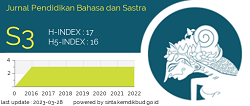Analisis Kemampuan Berpikir Kritis pada Buku Bahasa Indonesia Kelas X Sekolah Penggerak dan SMK Pusat Keunggulan
Abstract
Keywords
References
Anggareni, N. W., Ristiati, N. P., & Widiyanti, N. L. P. M. (2013). Implementasi Strategi Pembelajaran Inkuiri Terhadap Kemampuan Berpikir Kritis dan Pemahaman Konsep IPA Siswa SMP. e-journal Program Pascasarjana Universitas Pendidikan Ganesha Program Studi IPA, 3, 1–11.
Bassham, G., Irwin, W., Nardone, H., & Wallace, J. M. (2010). Critical Thinking : A’Students Introduction (4 ed.). McGraw-Hill.
Bouzid, H. A. (2016). Boosting 21 st Century Skills through Moroccan ELT Textbooks. Journal of English Language Teaching and Linguistics, 1(2), 97–108.
Butterworth, J., & Thwaites, G. (2013). Thinking Skills: Critical Thinking and Problem Solving. In Cambridge Press (2 ed., Vol. 2). Cambridge University Press. https://doi.org/10.1177/019263658506948024
Cahyani, H. D., Hadiyanti, A. H. D., & Saptoro, A. (2021). Peningkatan Sikap Kedisiplinan dan Kemampuan Berpikir Kritis Siswa dengan Penerapan Model Pembelajaran Problem Based Learning. Edukatif : Jurnal Ilmu Pendidikan, 3(3), 919–927. https://doi.org/https://doi.org/10.31004/edukatif.v3i3.472
Cottrell, S. (2005). Critical Thinking Skills. Developing Effective Analysis and Argument. In Contemporary Nurse. Palgrae Macmillan. https://doi.org/10.5172/conu.2007.25.1-2.174a
Duron, R., Limbach, B., & Waugh, W. (2006). Critical Thinking Framework For Any Discipline. International Journal of Teaching and Learning in Higher Education, 17(2), 160–166.
Elder, L., & Paul, R. (2010). Critical Thinking:Competency Standards Essential for the Cultivation of Intellectual Skills, Part 1. Jorunal of Developmental Education, 34(2), 1–2.
Fisher, A. (2005). Critical Thinking : An Introduction (5 ed.). Cambridge University Press.
Gunawan, I. M. A. A., Padmadewi, N. N., & Utami, I. G. A. L. P. (2022). The Analysis Of 4C Skills Representation In Eleventh Grade Senior High School’s English Textbook. Jurnal Pendidikan Bahasa Inggris Indonesia, 10(1), 66–76. https://doi.org/10.23887/jpbi.v10i1.883
Hadi, S., & Novaliyosi. (2019). Trends in International Mathematics and Science Study (TIMSS). Prosiding Seminar Nasional & Call For Papers Universitas Siliwangi, 562–599. https://doi.org/10.1007/978-94-6209-497-0_97
Halpern, D. F. (2014). Thought and Knowdlege : An Introduction to Critical Thiking (5 ed.). Psychology Press.
Hashemi, S. A., Naderi, E., Shariatmadari, A., Naraghi, M. S., Mehrabi, M., & Branch, B. (2010). Science Production in Iranian Educational System by The Use of Critical Thiking. International Journal of Instruction, 3(1), 61–76.
Ilyas, H. P. (2015). Critical Thinking : Its Representation in Indonesian ELT Textbooks and Education Hamzah Puadi Ilyas University of York Education February 2015 (Nomor February). University of York.
Ilyas, H. P. (2016). Infusing Critical Thinking into English Coursebooks. 1(1), 113–134.
Irafahmi, D. T., Nuris, D. M., Zahroh, F., & Nagari, P. M. (2018). Critical Thinking in Accounting Textbooks. Critical Thinking in Accounting Textbooks, 12(1), 21–29. https://doi.org/10.11591/edulearn.v12i1.6315
Krulik, S., & Rudnick, J. A. (1999). Innovative Tasks to Improve Critical and Creative Thinking Skilss. In Developing Mathematical reasoning in Grades K-12 (hal. 138–145). The National Council of Teachers of Mathematics.
Nainggolan, B. R., & Wirza, Y. (2020). Evaluation of an English Textbook : Does ‘ English in Mind ’ Promote Critical Thinking Skills ? Proceedings of the Thirteenth Conference on Applied Linguistics (CONAPLIN 2020), 546, 51–59.
Nuryanti, L., Zubaidah, S., & Diantoro, M. (2018). Analisis Kemampuan Berpikir Kritis Siswa SMP. Jurnal Pendidikan: Teori, Peneltian, dan Pengembangan, 3(2), 155–158.
Paul, R. W. (1990). Critical Thinking: What Every Person Needs to Survive In A Rapidly Changing World (A. J. A. Binker (ed.); 1 ed.). Center of Critical Thinking and Moral Critique : Sonoma State University.
Paul, R. W., Binker, A. J. A., & Weil, D. (1990). Critical Thinking Handbook : K-3rd Grades, A Guide for Remodellng Lesson Plans in Language Arts, Social Studies, & Science. Center of Critical Thinking and Moral Critique : Sonoma State University.
Putra, H. A. D., & Fitrayati, D. (2021). Efektivitas Model Pembelajaran Blended Learning Untuk Meningkatkan Keterampilan Berpikir Kritis Peserta Didik Pada Pelajaran Ekonomi. Edukatif : Jurnal Ilmu Pendidikan, 3(4), 1765–1774. https://doi.org/https://doi.org/10.31004/edukatif.v3i4.676
Rahayu, B. N. A., & Dewi, N. R. (2022). Kajian Teori : Kemampuan Berpikir Kritis Matematis Ditinjau dari Rasa Ingin Tahu pada Model Pembelajaran Preprospec Berbantu TIK. Prisma : Prosiding Seminar Nasional Matematika, 5, 297–303.
Schreier, M. (2012). Qualitative Content Analysis in Practice. In SAGE Publications. Sage.
Sekretariat-GTK.(2021a). Mengenal Sekolah Penggerak. https://gtk.kemdikbud.go.id/index.php/read-news/mengenal-program-sekolah-penggerak
Sekretariat-GTK. (2021b). Sekolah Penggerak adalah Katalis. https://gtk.kemdikbud.go.id/read-news/sekolah-penggerak-adalah-katalis
Siswono, T. Y. E. (2010). Leveling students’ creative thinking in solving and posing mathematical problem. Journal on Mathematics Education, 1(1), 17–40. https://doi.org/10.22342/jme.1.1.794.17-40
Solihati, N., & Hikmat, A. (2018). Critical Thinking Tasks Manifested in Indonesian Language Textbooks for Senior Secondary Students. SAGE Open, Juli-Septe(17), 1–8. https://doi.org/10.1177/2158244018802164
DOI: https://doi.org/10.17509/bs_jpbsp.v23i2.68692
Refbacks
- There are currently no refbacks.
Copyright (c) 2024 Jurnal Pendidikan Bahasa dan Sastra
p-ISSN 1412-0712 | e-ISSN 2527-8312
JPBS is published by:
Fakultas Pendidikan Bahasa dan Sastra (Faculty of Language and Literature Education), Universitas Pendidikan Indonesia,
in cooperation with
TEFLIN, and APPBIPA


